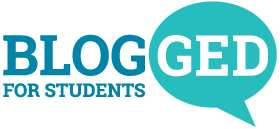The semicolon may not be as complicated as you may think; it’s simply misunderstood and often misused by students during the RLA test. In short, a semicolon is a mashup between a comma and a period. Comma + period = semicolon.

Parks and Recreation
Yep, it’s that simple but let’s talk more about how and when to use it.
The period:
A period is more definitive. It marks the end of a sentence, while a semicolon is more like a long pause, and then the sentence keeps going.
Think of a semicolon like a stop sign and a period like a red light.

WordPress
If you’re reading out loud (or driving), you would make a brief stop when you get to a semicolon (or stop sign). This pause is not as long as what you would do when you see a period at the end of a sentence (or a stoplight).
After a period, you could start a new paragraph; with a semicolon, you can’t make such a leap.
Examples:
- Mark saw a dog driving a blue car down the street; he believed the dog was alone in the car. [semicolon]
- Mark saw a dog driving a blue car down the street. He is concerned about the dog and the other drivers on the road. [period]
The Comma:
A comma separates clauses along with a conjunction such as “but” and “or.” A semicolon separates two main clauses; they are often complete enough to stand on their own but are part of the same thought.

SpongeBob SquarePants
We’ll leave Bikini Bottom and go back to the traffic light analogy for a moment. A comma indicates a short pause and functions similar to a yellow light, telling you to slow down as you read. A semicolon would still cause you to stop briefly, like at a stop sign.

Hey Arnold
When you read with a comma in your sentence, you keep going despite taking a quick pause.
Examples:
- Eugene is excited about his new bike, but he doesn’t know how to ride it. [comma]
- Arnold and Gerald are watching Eugene leave on his bike; they all just noticed the stop sign right ahead. [semicolon]
While our dear friend Eugene learns the importance of his brakes and stop signs, we can share one additional option you can use when pausing in a sentence.
Introducing….

SpongeBob SquarePants
The Colon:
Not that colon, even though it is important for bodily functions and deserves an honorable mention, we’re talking about the one that can start a list or clarify a command.
Examples:
- Your GED can help you do many things once you graduate: go to college, get a new job, and impress all your friends. [colon]
- Keep studying: we know you’ll do great! [colon]
That’s it for us, but we hope you’re as excited about English grammar as we are!

Community
If you want to learn more, we have study guides, interactive tools, and practice tests in your student account at GED.com.
Danielle W. Communications Manager. Word nerd. Middle-school spelling bee champ. Cupcake connoisseur.


